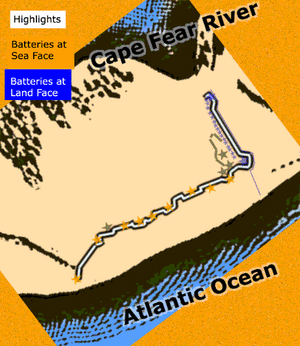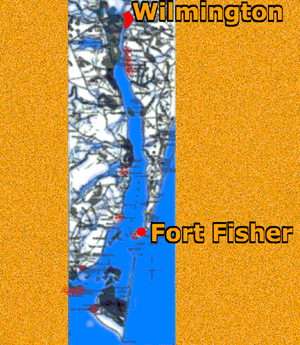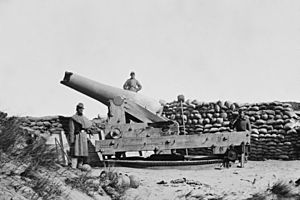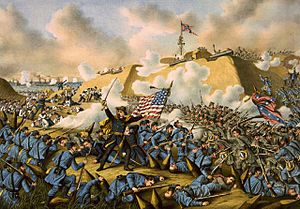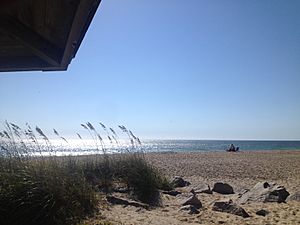Fort Fisher facts for kids
Quick facts for kids Fort Fisher |
|
|---|---|
| New Hanover County, near Wilmington, North Carolina |
|
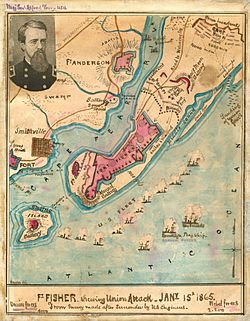
Union Attack on Fort Fisher, North Carolina, January 15, 1865
|
|
| Site history | |
| Built | 1861 |
| In use | 1861–1865 |
| Battles/wars | First Battle of Fort Fisher Second Battle of Fort Fisher |
| Events | |
|
Fort Fisher
|
|
| Lua error in Module:Location_map at line 420: attempt to index field 'wikibase' (a nil value). | |
| Nearest city | Wilmington, North Carolina |
| Area | 200 acres (81 ha) |
| Built | 1861 |
| Architect | Lamb, Col. William |
| NRHP reference No. | 66000595 |
| Added to NRHP | October 15, 1966 |
Fort Fisher was a very important Confederate fort during the American Civil War. It was built to protect the port of Wilmington, North Carolina, which was a key trading hub. The fort stood strong from 1861 until the Union captured it in 1865.
Fort Fisher was located on a piece of land called Pleasure Island today. This land was right at one of the two places where the Cape Fear River flows into the Atlantic Ocean. Because it was so strong, people called Fort Fisher the Southern Gibraltar and the "Malakoff Tower of the South." The battles fought here were some of the most important in North Carolina during the Civil War.
Contents
Significance of Fort Fisher
Why Wilmington Was Important
The city of Wilmington is about 29 miles (50 km) up the Cape Fear River from the ocean. During the Civil War, Wilmington was one of the most vital ports for the Confederacy. It was a place where the South could trade cotton and tobacco for important supplies. These supplies included ammunition, clothing, and food. This trade helped the southern states and General Robert E. Lee's army in Virginia.
Most of the trade happened with British ships called "blockade runners." These ships had to sneak past the Union's naval blockade. They often came from British colonies like Bermuda or The Bahamas. After Norfolk fell in 1862, Wilmington became the main Confederate port on the Atlantic. Its defenses were so strong that only Charleston in South Carolina had better ones. Fort Fisher was the main reason Wilmington stayed safe for so long.
How the Cape Fear River Was Protected
South of Wilmington, along the last 20 miles (30 km) of the Cape Fear River, there were many Confederate forts and batteries. The river channel was also filled with sunken ships and mines (called "torpedoes" back then). Confederate officers had to carefully guide each ship through these dangers.
At the mouth of the Cape Fear River, there were about six Confederate positions. The river flowed into the sea through two shallow inlets, separated by Smith Island. Having two inlets was a big advantage. Blockade runners could switch between the two inlets to avoid Union ships. The Confederacy built Fort Fisher at a good spot on the "New Inlet" side of the Federal Point peninsula.
Building Fort Fisher
Early Defenses
The first cannons were set up in the spring of 1861, about a mile from the New Inlet. Major Charles Pattison Bolles oversaw this work. The area was first called "Bolles Battery." Later, a training camp called Camp Wyatt was built nearby.
In the summer of 1861, Colonel Seawell L. Fremont added more batteries along the land strip. These included Meade Battery, Zeke's Island Battery, Anderson Battery, and Gatlin Battery. Around September, the whole place was officially named "Fort Fisher." It was named after Colonel Charles Frederick Fisher, who died in the First Battle of Manassas.
The area around the fort had few people, mostly small farms and pine woods. Confederate pilots would climb tall pine trees to spot incoming blockade runners. Then, they would go out to guide the ships safely past the fort's defenses to Wilmington. Fort Fisher was later given more powerful cannons from Charleston. This forced Union ships to stay far offshore, protecting the coast.
Making the Fort Stronger
In July 1862, Colonel William Lamb took command of Fort Fisher. He thought the fort needed a lot of work. Since Wilmington was so important for trade, the fort's defenses had to be very strong.
Workers built a line of earth mounds called the Land Face, which stretched to the sea. Later, the Sea Face was built, continuing the line of mounds down to what became Mound Battery. At the corner where these two faces met, a tall structure called the Northeast Bastion was built, standing 30 feet (9 m) high.
Mound Battery was the most important part of Fort Fisher. It was built in the spring of 1863 and needed hundreds of workers. A small train was used to dump soil to build the mound. A special light was put at the top to signal blockade runners.
Fort Fisher was mostly built of soil, which was very good at soaking up cannon fire. This design was inspired by the Tower of Malakoff, built in Russia during the Crimean War. Over time, more than a thousand people worked on the fort, including Confederate soldiers and enslaved people. Many of the enslaved people were brought from nearby plantations. Some Native Americans, mainly Lumbee Indians, were also made to help build the fort.
After these improvements, Fort Fisher became the largest Confederate fort. In November 1863, President Jefferson Davis visited the fort. By 1864, the entire 36th North Carolina regiment was stationed inside Fort Fisher. In October 1864, another important defense, Battery Buchanan, was built.
Protecting the Inlet
Union warships usually could not get past Fort Fisher's strong defenses. The fort's coastal cannons forced them to stay far away from the shore.
Land Defenses
The land defense stretched for 1,800 feet (540 m) and had fifteen mounds. It held twenty-five cannons that were 32 feet (10 m) above sea level. The mounds were connected by tunnels that protected soldiers from artillery fire. These underground areas also stored weapons. In front of the walls, there was a 9-foot (2.7 m) tall fence made of sharpened stakes.
Sea Defenses
The sea defense was one mile (1.6 km) long. It had 22 cannons placed 12 feet (3.6 m) above sea level, with two large batteries at each end. Two smaller mounds held extra cannons. There was also a telegraph office and a hospital that was protected from bombs.
Battery Buchanan
Battery Buchanan was a smaller but impressive fort built in 1864. It was at the very end of the peninsula, watching over Cape Fear's New Inlet. It was named after Admiral Franklin Buchanan of the Confederate Navy.
Fort Fisher's Weapons
The sea defenses had many 8-inch columbiad cannons, some 10-inch columbiads, and a mix of rifled 32-pounders and Brooke Rifles. A powerful 8-inch Blakeley Rifle was in the Northeast Bastion. An advanced 150-pound Armstrong Gun was placed along the sea face. Each cannon had Barbettes around it for protection.
The land defenses included 4.5-inch Parrott Rifles at Shepherd Battery. There were also two 24-pound Coehorn mortars and one 10-inch seacoast mortar along the land face. Smaller 12-pound Napoleon-M1857 cannons and a 3-inch Parrott Rifle were near the entrance. Two 12-pounders protected the middle entrance along the fort's land face.
Battles at Fort Fisher
The Union planned to capture Wilmington after Mobile, Alabama fell in August 1864. By September 1864, both Confederate spies and Union newspapers guessed that an attack on Charleston or Wilmington was coming soon.
Fort Fisher had 2,400 men, but they were not well-trained for a land attack. Because other battlefronts, especially Richmond, needed soldiers, the fort's defenders were slowly replaced by local North Carolina forces. The Cape Fear River was filled with more "torpedoes," and a defensive wall was built at the north end of the fort to stop any landing forces.
General Braxton Bragg was put in charge of the region. In November 1864, Bragg was ordered to join the fight against William T. Sherman in Georgia. For this, Bragg took 2,000 troops away from Wilmington's defenses. When Ulysses S. Grant heard about this, he started planning a full invasion.
The First Attack
On December 15, 1864, Jefferson Davis thought Wilmington hadn't been attacked yet because it would need too many Union troops. He believed if it was important enough, Union "fleets and armies" would already be there.
In December 1864, Union Major General Benjamin Butler led an army from Virginia to capture Fort Fisher by sea. He joined Rear Admiral David Dixon Porter, who commanded Union naval forces already in the area. When General Lee learned about the large Union army heading for Wilmington, he sent Major General Robert Hoke's Division to Fort Fisher. Hoke then took command of all Confederate forces in the Wilmington area.
The Union attack began on December 24, 1864, with a naval bombardment. Some of Fort Fisher's gun positions exploded, temporarily silencing its cannons. This allowed the Navy to land Union soldiers. However, Hoke's troops arrived and stopped the landing force. The Union attack failed, and on December 27, Benjamin Butler ordered his 1,000 soldiers still on the beach to leave. This went against Grant's orders to surround the fort if the first attack failed. Because Butler disobeyed, Grant removed him from command.
The Second Attack
Major General Alfred Terry replaced Butler, and the operation was called "Terry's expedition." Admiral Porter was again in charge of the naval attack. They waited until January 12, 1865, for their second try.
The new attack started with a very heavy and continuous bombardment from Porter's 56 ships. They first targeted both sides of Fort Fisher. On January 13, Porter focused fire on the fort itself, while Terry's army of 8,000 soldiers, led by Adelbert Ames, landed north of the fort. By mid-afternoon, the fort was completely cut off. Porter's ships fired all night and the next day. On January 15, a second force of 1,600 sailors and 400 Marines, led by LCdr. Kidder Breese, landed northeast of the fort.
At 3 p.m., Ames's soldiers attacked the northern, land face. At the same time, Breese's landing force attacked the fort's northeast bastion (where the land face met the sea face). Breese's attack was pushed back, but it distracted the defenders from the attack on the northern face. There, the Union soldiers entered the fort through Shepherd Battery. The Confederate defenders found themselves fighting inside their own walls and had to retreat.
The land battle lasted six hours. That night, General William H. C. Whiting, who was wounded during the battle, surrendered. He was taken prisoner and died in prison on March 10, 1865. Confederates who were captured and not wounded were sent to a prison in Elmira, New York. Wounded Confederates went to Hammond General Hospital and were later moved to the main prison at Point Lookout, Maryland. Many guards at Point Lookout were former enslaved people who had joined the Union army.
What Happened After the Battles
With Fort Fisher captured, the trading route to Wilmington was cut off. This also cut off supplies for General Robert E. Lee's Army of Northern Virginia. After Fort Anderson on the Cape Fear River fell, the Union took control of Wilmington on February 22, 1865. The Civil War officially ended two months later.
The Magazine Explosion
Shortly after sunrise on January 16, 1865, Fort Fisher's main gunpowder storage (magazine) exploded. This huge blast killed at least 200 men from both sides.
Visiting Fort Fisher Today
The site was named a National Historic Landmark in 1961, the first in North Carolina. Today, it is part of the Fort Fisher State Historic Site. This includes the main fort area, a museum, and a visitor center. Undersea archaeology (studying things underwater) is also done around the site. The Fort Fisher State Recreation Area is next to the historic site. What's left of Battery Buchanan is part of the North Carolina National Estuarine Research Reserve's Zeke's Island site.
The museum has a map of the 1865 battle with 3D models of Fort Fisher and Battery Buchanan. The map tells the story of the battle with lights showing where troops moved. Other exhibits show parts of the battle, what life was like at the fort, Union and Confederate soldier clothing and gear, weapons from that time, local history, Fort Fisher's role in World War II, and items found during digs at the fort.
Because of natural erosion from the sea, and the building of US 421 and an airstrip during World War II, only a few of the original sand mounds remain. Part of the original land face fence has been rebuilt.
Visitors can take a tour around the rebuilt areas of the fort, with signs explaining things. A restored 32-pound seacoast cannon is at Shepherd's Battery and is fired on special occasions. Guided tours are given daily, and sometimes there are special tours with people in costumes. Fort Fisher's original 150-pound Armstrong cannon is now at West Point, New York, displayed at "Trophy Point."
Fort Fisher is also featured in an exhibit at the Cape Fear Museum in downtown Wilmington. This includes impressive models of the fort and the Civil War waterfront of Wilmington.
Images for kids
-
Bernard Tobey, a double amputee and his son, wearing Union sailor uniforms, standing beside a small wagon displaying Secretary of War Edwin Stanton's dispatch on the fall of Fort Fisher. From the Liljenquist Family Collection of Civil War Photographs, Prints and Photographs Division, Library of Congress


